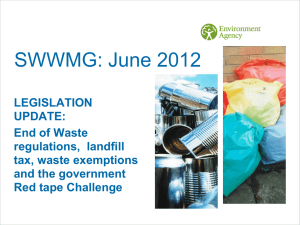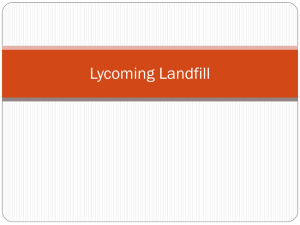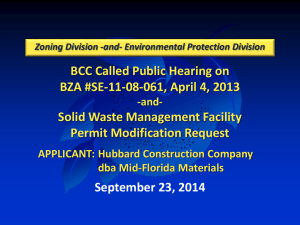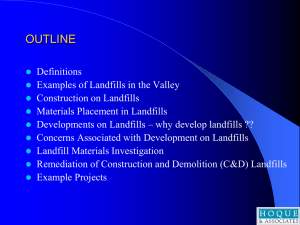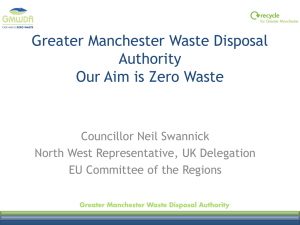Integrating Construction, Demolition, and Recycling By
advertisement
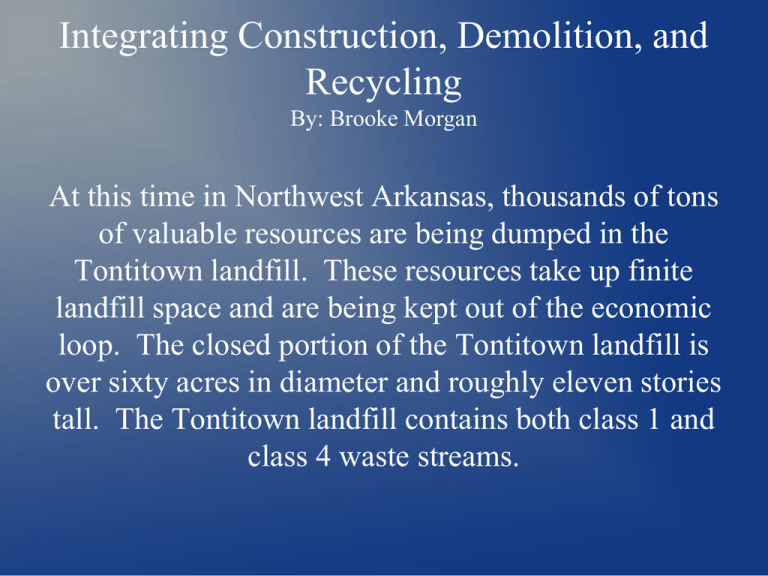
Integrating Construction, Demolition, and Recycling By: Brooke Morgan At this time in Northwest Arkansas, thousands of tons of valuable resources are being dumped in the Tontitown landfill. These resources take up finite landfill space and are being kept out of the economic loop. The closed portion of the Tontitown landfill is over sixty acres in diameter and roughly eleven stories tall. The Tontitown landfill contains both class 1 and class 4 waste streams. Defintion of Class 1 Landfill ● More commonly known as trash or household garbage, MSW (Municipal Solid Waste) consists of the non-hazardous waste we use every day. A Class 1 landfill is where the items we throw away is buried after being picked up by garbage trucks. Product packaging, plastic bottles, food scraps and newspaper from our homes, schools and businesses are dumped in Class 1 category landfills. * Definition of Class 4 Landfill ● A Class 4 landfill area will contain waste building materials, deredging materials, tree stumps, and rubble resulting from construction, remodeling, renovation, repair, and demolition of homes, businesses and other commercial buildings, structures and pavements. Some of these materials may contain lead, asbestos, or other hazardous materials. Class 4 Waste (Continued) Even if people take into consideration that what we use in our houses goes to the landfill, we may not necessarily think of how much waste is accumulated in the building of our homes. ● ● C&D debris consists of materials such as concrete, wood, asphalt, gypsum, metals, bricks, glass, and plastics; along with salvaged components such as windows, doors, and plumbing fixtures. Most C&D waste ends up in a landfill. Only approximately 10% is recovered for other usage. ● MSW Generation** This is a closed portion of the Class 1 area in the Tontiown landfill. 4 landfill area. This is separate from municipal solid waste (MSW); however, it is sti This Is Our Class 4 Landfill rty minutes five garbage trucks unloaded between six and fifteen tons of waste each. This C&D Pie Chart** Few of these resources are recycled; 90% are sent to landfills. How Big a Piece of the Waste Stream Pie is Construction and Demolition?** m the pie chart, construction and demolition trash accounts for approximately 17% Waste Facts ● ● ● The Tontitown landfill is the only landfill in Northwest Arkansas. The Tontitown community receives $1.50 for every ton of garbage interred in the landfill. Up to 33 million tons of waste have been saved from landfills and incinerators across America from 1990 to 2000. Construction and Demolition and the Waste It Creates ● For my service learning project, I learned about the different stages of residential construction. The following slides present the different phases of construction and the waste produced by each stage. First Phase of Construction Framing the house takes about two weeks, weather permitting. Debris and wood scraps of all shapes and sizes are discarded. Some wood scraps are treated though most are not. Small wood scraps could be turned into pellets for wood-burning stoves. ● Second Phase of Construction ● Mechanics take about 2-3 weeks. This is when the plumbing, heat and air get put in, as well as the electrical. At the same time, the brick, siding and roof are being installed. Debris from this phase include cardboard, PVC, copper, other types of metal , excess wiring, and plastic wrappings that packaged the fixtures. Third Phase of Construction Dry-in takes 4-5 days. During this phase, the roof gets tar-papered and shingled. Accumulated debris includes asphalt shingles and tar-paper. ● Fourth Phase of Construction ● ● Roughing-In – Involves the installation of sheet rock and insulation. This phase lasts 2-3 days. Leftover sheet rock and insulation scraps account for debris amassed during the Roughing-In stage. Final Phase of Construction ● ● “Finishing Out” - During this phase, enough debris is accumulated to fill a two-car garage. From this phase of construction, materials such as cardboard, shrink-wrap, and Styrofoam from all of the electrical fixtures and appliances account for the collected waste. Challenges of Removing Construction Debris from the Job Site ● The space on site; ● The space in the street; ● The weather; ● The scheduling of different subcontractors; ● Having a reliable mobile unit to remove the debris in a timely manner. Solutions for Removing Construction Debris from a Job Site ● ● ● ● An independent firm with flexible laborers, able to remove construction waste at any given time. Senior citizens who are able to pick up, and subsequently utilize, lumber scraps, et cetera for projects. Have Eagle Scouts earning badges to participate in a construction site clean up project. An on-site mulcher owned by the primary contractor to mulch leftover wood debris. Conclusion Many people think about Class 1 waste, the waste that results from daily living. However, few people outside builders and contractors think about all of the Class 4 waste, which is waste generated during the construction, renovation or demolition of a home or business. ● Class 4 waste has value that isn't being realized. By landfilling this waste we are keeping valuable resources out of the economic loop. ● There is an entrepreneurial opportunity for someone who is able to figure out how to remove items from the construction site and be able to place the assets in an appropriate market place. ● Special Thanks ● Louise Mann ● Mikel Lolley ● Gavin Edwards ● John Frank Sources ● United States Environmental Protection Agency website for facts and defintions (epa.gov) ● Louise Mann ● Gavin Edwards ● **Google Images for charts




